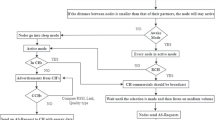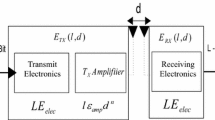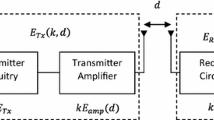Abstract
A wireless sensor network (WSN) is composed of sensor nodes whose energy is battery-powered. Therefore, the energy is limited. This paper aims to improve the energy efficiency of sensor nodes in order to extend the lifetime of WSNs. In this paper, we propose four new hierarchical clustering topology architectures: random cluster head and sub-cluster head (RCHSCH), random cluster head and max energy sub-cluster head (RCHMESCH), random cluster head and sub-cluster head with sleep mode (RCHSCHSM) and random cluster head and max energy sub-cluster head with sleep mode (RCHMESCHSM). Our proposed architectures involve three-layers and are based on low-energy adaptive clustering hierarchy (LEACH) architecture. Notably, RCHSCH can improve upon cluster head death within the LEACH architecture. In addition, we develop a sleep mode for sensor nodes based on correlations among sensor data within sub-clusters in RCHSCHSM. Thus, we can reduce the energy consumption of the sensor node and increase energy efficiency. From the simulation results, our proposed RCHSCH, RCHMESCH, RCHSCHSM and RCHMESCHSM architectures perform better than the LEACH architecture in terms of initial node death, the number of nodes alive and total residual energy. Furthermore, we find the performance of RCHMESCHSM architecture to be optimal in the set of all available architectures.











Similar content being viewed by others
References
Akyilidiz, I. F., Su, W., Sankarasubramaniam, Y., & Cayirci, E. (2002). A survey in sensor networks. IEEE Communications Magazine, 40(8), 102–114.
Akkaya, K., & Younis, M. (2005). A survey on routing protocols for wireless sensor networks. Ad Hoc Networks, 3(3), 325–349.
Du., X., & Lin, F. (2005). Improving routing in sensor networks with heterogeneous. In Proceedings of the 61st IEEE vehicular technology conference (vol. 4(5), pp. 2528–2532).
Thanayankizil, L. V., Kailas, A., & Ingram, M. A. (2011). Opportunistic large array concentric routing algorithm (OLACRA) for upstream routing in wireless sensor networks. Ad Hoc Networks, 9(7), 1140–1153.
Saleem, M., Ullah, I., & Farooq, M. (2012). BeeSensor: An energy-efficient and scalable routing protocol for wireless sensor networks. Information Sciences, 200, 38–56.
Akba, M. I., Brust, M. R., & Turgut, D. (2011). SOFROP: Self-organizing and fair routing protocol for wireless networks with mobile sensors and stationary actors. Computer Communications, 34(18), 2135–2146.
Liu, A., Ren, J., Chen, Z., & Shen, X. (2012). Design principles and improvement of cost function based energy aware routing algorithms for wireless sensor networks. Computer Networks, 56(7), 1951–1967.
Zeydan, E., Kivanc, D., Comaniciu, C., & Tureli, U. (2012). Energy-efficient routing for correlated data in wireless sensor networks. Ad Hoc Networks, 10(6), 962–975.
Chen, Y. L., & Lin, J. S. (2012). Energy efficiency analysis of a chain-based scheme via intra-grid for wireless sensor networks. Computer Communications, 35(4), 507–516.
Gao, T., Jin, R. C., Song, J. Y., Xu, T. B., & Wang, L. D. (2010). Energy efficient cluster head selection scheme based on multiple criteria decision making for wireless sensor networks. Wireless Personal Communications, 63(4), 871–894.
Yu, J., Qi, Y., Wang, G., & Gu, X. (2012). A cluster-based routing protocol for wireless sensor networks with nonuniform node distribution. International Journal of Electronics and Communications (AEU), 66(1), 54–61.
Pantazis, N. A., Vergados, D. J., Vergados, D. D., & Douligeris, C. (2009). Energy efficiency in wireless sensor networks using sleep mode TDMA scheduling. Ad Hoc Networks, 7(2), 322–343.
Heinzelman, W. B., Chandrakasan, A., & Balakrishnan, H. (2002). An application-specific protocol architecture for wireless microsensor networks. IEEE Transactions on Wireless Communications, 1(4), 660–670.
Bajaber, F., & Awan, I. (2011). Adaptive decentralized re-clustering protocol for wireless sensor networks. Journal of Computer and System Sciences, 77(2), 282–292.
El-Basioni, B. M. M., El-Kader, S. M. A., Eissa, H. S., & Zahra, M. M. (2011). An optimized energy-aware routing protocol for wireless sensor networks. Egyptian Informatics Journal, 12(2), 61–72.
Lee, E., Park, S., Yu, F., & Kim, S. H. (2010). Data gathering mechanism with local sink in geographic routing for wireless sensor networks. IEEE Transactions on Consumer Electronics, 56(3), 1433–1441.
Gedik, B., Liu, L., & Yu, P. S. (2007). ASAP: An adaptive sampling approach to data collection in sensor. IEEE Transactions on Parallel and Distributed Systems, 18(12), 1766–1783.
Acknowledgments
This work was supported in part by the National Science Council (NSC) of the Republic of China under Grant No. NSC100-2221-E-025-008.
Author information
Authors and Affiliations
Corresponding author
Rights and permissions
About this article
Cite this article
Chen, YL., Wang, NC., Shih, YN. et al. Improving Low-Energy Adaptive Clustering Hierarchy Architectures with Sleep Mode for Wireless Sensor Networks. Wireless Pers Commun 75, 349–368 (2014). https://doi.org/10.1007/s11277-013-1366-7
Published:
Issue Date:
DOI: https://doi.org/10.1007/s11277-013-1366-7




